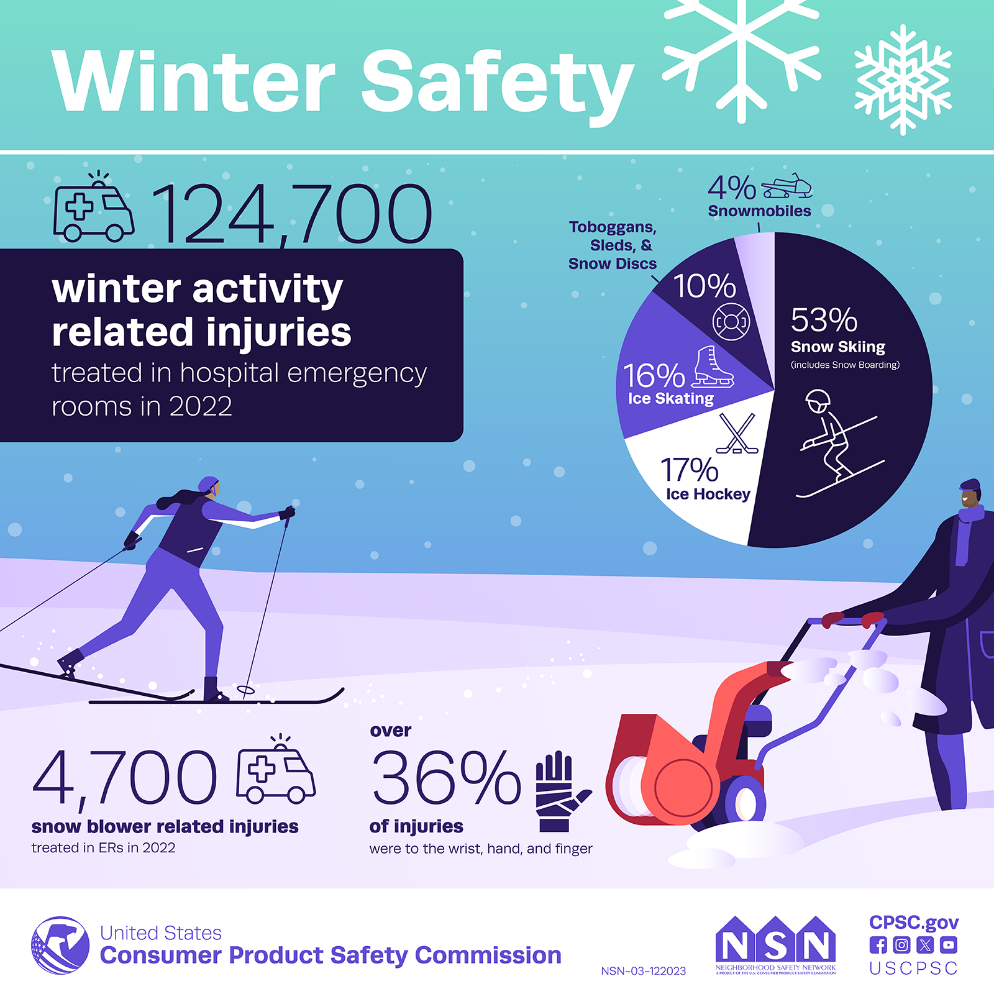WASHINGTON, D.C. – Along with bone chilling temperatures, the winter season can bring a host of outdoor activities like sledding, skating, and skiing, as well as chores like using a snow blower. In an effort to reduce winter hazard incidents, the U.S. Consumer Product Safety Commission (CPSC) is urging consumers to keep safety in sight while playing or working in cold weather.
According to the latest CPSC data, in 2022, there were an estimated 124,700 winter sports-related injuries treated in emergency rooms nationwide. Of all injuries:
- 53% occurred during snow skiing and snowboarding,
- 17% during ice hockey,
- 16% while ice skating,
- 10% while using toboggans, sleds, and snow discs,
- and 4% while using snowmobiles.
Common injuries from winter sports include sprains, strains, dislocations, and fractures. But even if you are not playing winter games, caution and care must be taken while doing outdoor chores like using a snow blower. Last year there were over 4,700 snow blower-related injuries treated in the ER, with 36 percent of those injuries to the wrist, hand, and/or finger.
Many of these incidents can be avoided by following some practical safety tips while enjoying the winter wonderland.
Winter Sports Safety – Helmets Make a Difference
- Wear appropriate protective gear, including goggles, helmets, gloves, and padding.
- Wear a properly fitted helmet to reduce the risk of a head injury.
- Wear the right helmet for the activity. Check out our helmet safety publication Which Helmet for Which Activity for more information.
- Check that equipment is working properly prior to use.
Snow Blower – Clear Snow Safely
- Do NOT try to clear snow from the discharge chute of a snow blower with your hands – this is when most snow blower injuries happen.
- Read the snow blower’s manual before using it.
- NEVER leave a gas-powered snow blower running in an enclosed area. The exhaust contains poisonous carbon monoxide, which can kill in minutes.
- To avoid fire, do not add gasoline to a running or hot engine; always keep the gasoline in a gas can or portable gasoline container with a child-resistant closure to prevent child poisonings.
Check for Recalls
- Check your home before bringing out winter-related products, check if your products were previously recalled.
- Report any unsafe products or any incidents where someone was injured by a product to CPSC at SaferProducts.gov.
About the U.S. CPSC
The U.S. Consumer Product Safety Commission (CPSC) is charged with protecting the public from unreasonable risk of injury associated with the use of thousands of types of consumer products. Deaths, injuries, and property damage from consumer product-related incidents cost the nation more than $1 trillion annually. Since the CPSC was established more than 50 years ago, it has worked to ensure the safety of consumer products, which has contributed to a decline in injuries associated with these products.
Federal law prohibits any person from selling products subject to a Commission ordered recall or a voluntary recall undertaken in consultation with the CPSC.
For lifesaving information:
- Visit CPSC.gov.
- Sign up to receive our email alerts.
- Follow us on Facebook, Instagram, X, BlueSky, Threads, LinkedIn and Truth Social.
- Report a dangerous product or a product-related injury on www.SaferProducts.gov.
- Call CPSC’s Hotline at 800-638-2772 (TTY 800-638-8270).
- Contact a media specialist.
Please use the below phone number for all media requests.
Phone: (301) 504-7908
Spanish: (301) 504-7800


